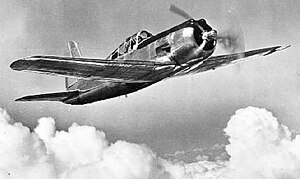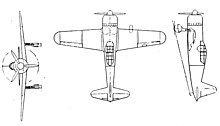Vultee P-66 Vanguard
| P-66 Vanguard | |
|---|---|

| |
| Vultee P-66 in flight. | |
| Role | Fighter |
| Manufacturer | Vultee Aircraft |
| Designer | Richard W. Palmer |
| First flight | 8 September 1939 (Model 61) |
| Introduction | 1941 (date shipment completed) |
| Retired | 1943 (USA) |
| Primary users | Chinese Nationalist Air Force
|
| Produced | 1940–1942 |
| Number built | 146 |
The Vultee P-66 Vanguard was a United States Army Air Forces fighter aircraft. It was initially ordered by Sweden, but by the time the aircraft were ready for delivery in 1941, the United States would not allow them to be exported, designating them as P-66s and retaining them for defensive and training purposes. Eventually, a large number were sent to China where they were pressed into service as combat aircraft with mixed results.
Design and development
Vultee's chief engineer Richard W. Palmer, made an all out effort to secure substantial military orders on the eve of
In 1938, Richard W. Palmer started the detailed design of the V-48 fighter member of the quartet. The aircraft featured a metal-covered, semi-monocoque fuselage and fully retractable
Operational history

On 6 February 1940, the Swedish government ordered 144 Vanguards as the V-48C. The production prototype flew on 6 September 1940. The model V-48C was similar to the V-48X except for installation of a later version of the R-1830 engine with better higher altitude performance and provision for four .30 in (7.62 mm) machine guns in the wings and two .50 in (12.7 mm) machine guns in the fuselage.
When production deliveries began in September 1941, the U.S. government placed an embargo on exporting the aircraft to Sweden. In the aftermath of Pearl Harbor, all Vanguards were assigned the designation P-66. Production ended in April 1942. Approximately 50 aircraft were retained by the USAAF and primarily used at pursuit training bases in the western U.S. and were deployed to the 14th Pursuit Group in defensive roles.[4] Although pilots were impressed by the P-66's handling, the type was considered less than robust and a tendency to ground-loop led to 15 aircraft being destroyed in landing accidents.
The British government took possession of 100 P-66s as the Vanguard I with plans to use the aircraft as an advanced trainer in Canada. After concluding their trials however, the British then relinquished the aircraft to China where 104 Vanguards (including USAAC examples) were shipped under the Lend-Lease program. They were originally intended to equip the 3rd American Volunteer Group (AVG); however, plans for additional groups were dropped after the Japanese attack on Pearl Harbor.
The Chinese received the assembled fighters via
The P-66 in Chinese service was largely replaced by
Operators
- Chinese Nationalist Air Force
- 3rd Group
- 5th Group
- Royal Air Force, not used, aircraft originally ordered by Sweden, aircraft were delivered to China.
Specifications (P-66)

Data from Skyways
General characteristics
- Crew: 1
- Length: 28 ft 5 in (8.66 m)
- Wingspan: 35 ft 10 in (10.92 m)
- Wing area: 196.8 sq ft (18.28 m2)
- Empty weight: 5,237 lb (2,375 kg)
- Gross weight: 7,100 lb (3,221 kg)
- Max takeoff weight: 7,384 lb (3,349 kg)
- Powerplant: 1 × Pratt & Whitney R-1830-33 14 Cyl twin row radial, 1,200 hp (890 kW)
- Propellers: 3-bladed Hamilton Standard hydromatic
Performance
- Maximum speed: 300 kn (340 mph, 550 km/h) at 15,000 ft
- Cruise speed: 250 kn (290 mph, 470 km/h) at 17,000 ft
- Stall speed: 71 kn (82 mph, 132 km/h)
- Range: 740 nmi (850 mi, 1,370 km)
- Service ceiling: 28,200 ft (8,600 m)
- Rate of climb: 2,520 ft/min (12.8 m/s)
Armament
- Guns: 4 × .30 in (7.62 mm) machine guns; 2 × .50 in (12.7 mm) machine guns
See also
Related development
Aircraft of comparable role, configuration, and era
Related lists
- List of aircraft of World War II
- List of fighter aircraft
- List of military aircraft of the United States
References
- Notes
- ISBN 0913322024.
- ^ Skyways: 4. July 2001.
{{cite journal}}: Missing or empty|title=(help) - ^ "P-66 Vanguard". World War II Database. Retrieved 3 October 2012.
- ^ Thompson 1992, p. 56.
- ^ Baugher, Joe. "Vultee P-66." Joe Baugher's Encyclopedia of American aircraft, last revised 19 September 1999. Retrieved: 12 June 2010.
- Bibliography
- Green, William. War Planes of the Second World War, Volume Four: Fighters. London: MacDonald & Co. (Publishers) Ltd., Sixth impression, 1969, First edition 1961. ISBN 0-356-01448-7.
- Green, William and Gordon Swanborough. WW2 Aircraft Fact Files: US Army Air Force Fighters, Part 2. London: Macdonald and Jane's Publishers Ltd., 1978. ISBN 0-354-01072-7.
- Lawrence, Joseph (1945). The Observer's Book Of Airplanes. London and New York: Frederick Warne & Co.
- Mondey, David. The Hamlyn Concise Guide to American Aircraft of World War II. London: Hamlyn Publishing Group Ltd., 1982 (republished 1996 by the Chancellor Press, reprinted 2002). ISBN 1-85152-706-0.
- Thompson, Jonathan. Vultee Aircraft 1932–1947. Santa Ana, Calif.: Narkiewicz/Thompson, 1992. ISBN 0-913322-02-4.
